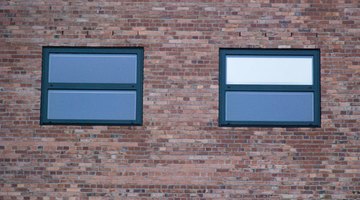How to Use an Angle Iron With Brickwork
Walls made from brick and mortar or brick veneer cladding have high strength in compression but are very weak in tension. This means that brickwork will support vertical loads well but will not bridge gaps or openings such as over windows and doors without additional support. Such support may also be required along the bottom of the brick wall or brick veneer cladding if the foundation is inadequate. In all these cases, angle irons of a suitable size can be used to support the brick.

Step 1
Prepare a window opening for an angle iron in the brickwork. Create the horizontal sill by laying bricks on edge with the long sides pointing out and sloped slightly down and out from the wall. This will create a surface that will spill water running down from the window out over the rest of the brick wall. Calculate the width of mortar thickness that will be required to build the sides so that the top brick will be just slightly higher than the top of the window frame. Build up the sides to the required height.
Step 2
Use an angle iron to bridge the opening by placing an angle iron across the top of the bricks. The vertical part of the angle iron must be the height of the bricks and stick up to support the next layer of brick from the back. The horizontal part must be the width of the bricks, and the next layer of bricks must be laid on the horizontal surface. The angle iron must protrude several inches over the bricks on either side of the opening and its thickness must be less than the thickness of the mortar joints so that it can be mortared into place.
Step 3
Use an angle iron to bridge an opening for a door in the same way. A horizontal sill is not required because the doorsill will cover the tops of the row of bricks along the bottom of the opening. Leave the top of these bricks bare and calculate the thickness of mortar required for the top brick on each side to reach slightly higher than the door frame. Build the sides and install the angle iron across the top as described in Step 2.
Step 4
Use an angle iron to support the brickwork when the ledge left on the foundation is not wide enough. A typical foundation might be 8 inches thick so that, once 2-by-6 wood framing is put into place, the ledge left to support the brickwork will be too narrow for full-sized bricks. Place an angle iron the width of the bricks on the ledge and lag bolt the vertical part to the wood framing. The framing is normally on 16-inch centers so that a lag bolt should be placed into each stud. Then place the first row of bricks on the horizontal part of the angle iron and mortar into place. Fasten the brick wall to the framing by inserting fasteners into the mortar.
References
Writer Bio
Bert Markgraf is a freelance writer with a strong science and engineering background. He started writing technical papers while working as an engineer in the 1980s. More recently, after starting his own business in IT, he helped organize an online community for which he wrote and edited articles as managing editor, business and economics. He holds a Bachelor of Science degree from McGill University.
Photo Credits
- doppel fenster image by oliver-marc steffen from Fotolia.com
More Articles


